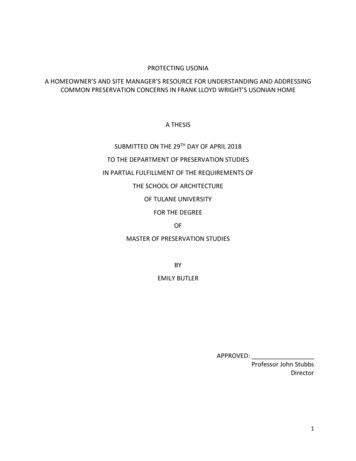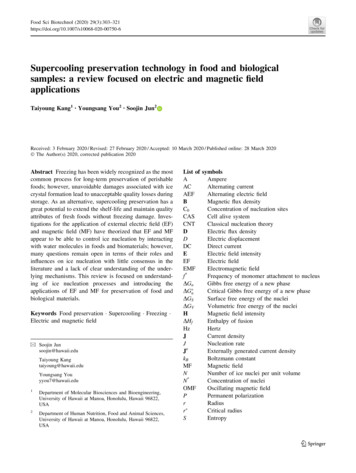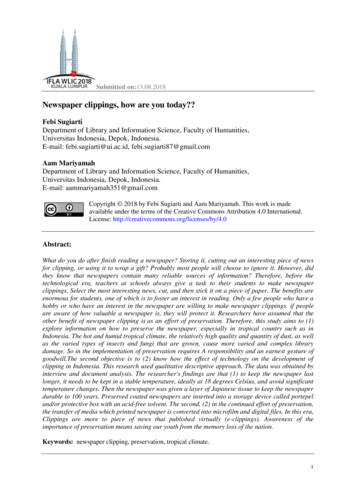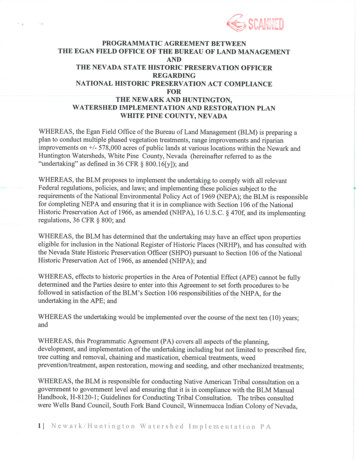
Transcription
PROTECTING USONIAA HOMEOWNER’S AND SITE MANAGER’S RESOURCE FOR UNDERSTANDING AND ADDRESSINGCOMMON PRESERVATION CONCERNS IN FRANK LLOYD WRIGHT’S USONIAN HOMEA THESISSUBMITTED ON THE 29TH DAY OF APRIL 2018TO THE DEPARTMENT OF PRESERVATION STUDIESIN PARTIAL FULFILLMENT OF THE REQUIREMENTS OFTHE SCHOOL OF ARCHITECTUREOF TULANE UNIVERSITYFOR THE DEGREEOFMASTER OF PRESERVATION STUDIESBYEMILY BUTLERAPPROVED:Professor John StubbsDirector1
Table of ContentsChapter 1 Introduction 3Personal Statement . .3Primary Goals 6Methodology .7Chapter 2 Understanding Wright .9Historical Background .9Organic Architecture As Described By Wright .13Usonia: Concept to Reality 16Usonian Forms: Module and Unit System .25Common Building Materials and Elements 30A Note on Sustainability .32Chapter 3 Case Studies in Preserving Usonian Homes 33Case Study: Herbert Jacobs House . 33Case Study: Kentuck Knob – I.N. & Bernardine Hagan House .40Case Study: Rosenbaum House .57Case Study: Pope-Leighey House .66Chapter 4 Homeowners and Public Sites Survey 71Survey Results 74An Analysis of the Results .87Failure of In-Floor Radiant Heating Systems .88Leaking Roofs .101Failure of Exterior Roof Finish/Wood Degradation .116Cracked or Damaged Concrete Floors .126Mortar Deterioration 132Retro-fitting: Glass .137Extraneous Concerns 140Deflecting/ Sagging Cantilever .140Textile/Concrete Block Deterioration .142Resources for Locating Specialized Contractors and Materials .148Conclusions 1492
Chapter 1 IntroductionPersonal StatementThis thesis topic was inspired by my intimate experience with a facet of Frank LloydWright’s architecture; a Usonian home commonly referred to as Kentuck Knob but known moreformally as the I.N. and Bernardine Hagan house. When I left college, I became employed at thishouse, which is run as a publicly toured house museum. I had had no previous experienceworking with a mid-century style of home, much less a Frank Lloyd Wright design. As such, I wasthrown into a situation where I had to learn very quickly the intricacies of the house. WhileKentuck Knob is in good shape it was far from idyllic – needing wood refinished, repointing ofthe front steps, and a repair of a leaky kitchen roof.As I was now the person who would be addressing these issues I had to learn quickly todevelop a preservation plan for the home. This baptism by fire was the true inspiration for mythesis topic, which attempts to identify and propose solutions for common preservationproblems that occur in Frank Lloyd Wright Usonian homes. Once these issues are identified thisthesis will attempt to give potential solutions by providing case study preservation projects,suggesting materials or resources, and discussing proper methodology and preservationpractice for addressing the most common issues.The first step in understanding the issues present in these homes is to understand FrankLloyd Wright, his design, and his philosophy on architecture. This is done in this thesis by a brief3
analysis of his personal and professional life. Wright’s history plays a major role in how hedeveloped his Usonian concept.The second step is to clearly define Wright’s Usonian designs and how they reflectWright’s personal beliefs and design philosophies. This section will outline the history behindthe development of the Usonian concept including historical context, its architecturalcharacteristics, and will discuss variations within those characteristics.With this important background information in hand, the paper then moves to discusscase study Usonian houses that have either undergone extensive restoration projects, havebeen re-sited, or are quintessential examples of successful preservation projects. The casestudy houses include the Rosenbaum House in Florence, Alabama; Kentuck Knob in Chalk Hill,PA; Jacobs I in Madison, Wisconsin, and the Pope-Leighey house currently located at theWoodlawn property in Virginia. These are not the only houses studied within this paper butserve to provide as examples that can be applied to other homes.Common preservation or conservation problems were researched and analyzed as apart of the scope of this work. The most common issues are addressed here in detail, describingthe typical nature of the failure, identifying first steps in addressing these issues, and givingresources and examples of successful methodologies and materials.It is the end goal of this thesis that all these combined elements will create a resourcefor understanding and addressing these common concerns for homeowners and site managersof Wright’s Usonian designs, which exist all across the United States.4
The large majority of the data and first-hand knowledge comes from homes ownedprivately. It is the fact that most of these homes are in private hands, lived in everyday, or caredfor on a regular basis by a community, trust, or other private or non-profit organization that somany remain with us and that so many will be preserved for future generations of inhabitants.It with this belief in the importance of the homeowners and organizations as major forces inpreservation that this thesis is being written as a guide to help these stewards in preserving apiece of architectural history.5
Primary GoalsThe primary goal of this thesis is to provide owners and stewards of Usonian homes withas many possible resources to make informed maintenance and conservation decisions,believing that in giving these resources to those most involved with the process these extantUsonian homes will be preserved to the highest degree of integrity. It was vital that most of theinformation come from homeowner’s themselves, as they have the most current, in-depth andpractical knowledge about common preservation concerns in the Usonian style of home. As apart of this goal first hand knowledge from the Usonian homeowners were collected, analyzed,and synthesized to develop a usable resource based on their experiences and additionalresearch and recommendation from professionals in the field.The secondary goal of this project is to contribute to the current database of the FrankLloyd Wright Building Conservancy on Usonian homes. The results of the survey will be includedin the database and will contribute to their mission. The Frank Lloyd Wright BuildingConservancy works to provide in-depth resources for homeowner’s as well as serves as one ofthe premier advocates for the preservation of Wright’s extant buildings. As such, they offerextensive practical preservation resources for all Wright homeowners. This paper, and the datacollected from the survey, will serve to increase their knowledge base and, therefore, theirability to provide more in-depth resources to all homeowners, stewards, and scholars.6
MethodologyThe methodology in developing this thesis can be largely broken down into three mainsections through which most of the information in this work is sourced. These three sectionswork together to make-up the resources needed to create a thorough, valid, and usefulresource.The initial step in the research process was to develop a comprehensive bibliography onthe subject of Frank Lloyd Wright’s life and work, his Usonian concepts and designs, and thepreservation of his buildings, Usonian or otherwise. As Wright is one of the most celebratedarchitects in the United States, there is plethora of literature on these subjects. After thiscompilation process, it was then prudent to sift through what was useful for this project. Thisliterature review provided valuable background information on Wright’s life and the Usonianhomes. Additionally, this literature also provided information on several of the case studyhouses, their history, and restoration projects. Later in the research process, the literaturereview was expanded to include technical information on the building systems and materials inthe common preservation concerns section and the suggestions therein.As this thesis focuses on both past and current preservation issues within these homes,it was important to gather information from the current or recent-past owners of some ofthese Usonian homes. This information was gathered in two primary ways. The first of whichwas in person or phone interviews with owners or stewards, discussing their experiencespreserving their home or the issues they felt were most prevalent. This methodology wasinitially implemented with the case study homes; however, it was necessary to cast a wider net.7
A Usonian Homeowner’s Survey was developed with the assistance of the Frank LloydWright Building Conservancy and distributed to their database of Usonian homeowners.Working with the Frank Lloyd Wright Building Conservancy was an invaluable resource as theirgoals and mission are in line with the goals of this thesis. This survey served to capture morequalitative, as well as quantitative, data on the most common preservation concerns or issuesamong Usonian homes. The complete survey can be viewed in the appendix of this work. Thecombination of these methodologies has gathered the needed information for a thoroughanalysis necessary for this paper and has been effective in making conclusions about issues andtheir solutions.8
Chapter 2Understanding Wright: Historical BackgroundA Look at Frank Lloyd Wright’s Life & CareerEarly YearsFrank Lloyd Wright was born to William Carey Wright and Anna Lloyd Jones in RichlandCenter, Wisconsin in 1867. His father, a preacher and musician, was often on the road andWright spent most of his time with his mother. Anna Lloyd Jones’, Wright’s mother, came froma large family who held strong beliefs in the Unitarian religion and followed the philosophies ofthinkers and authors such as Thoreau and Emerson. 1Anna had believed, when she was carrying Wright, that he was destined to become anarchitect and gave him Froebel blocks to play with as a young boy, which eventually would beinfluential in his career. Froebel’s simple geometry would stay with Wright through his entirecareer, stating that he could feel the blocks in his hands towards the end of his life.A love of nature is also something that Wright learned at an early age. Wright spentsummers on his uncle’s farm in Wisconsin, learned the value of hard work, and learned torespect and revere the land. Wright would eventually emulate this physical connection to theland with the Fellowship at Taliesin and Taliesin West.1Ian Volner and Michael Kirkham, This is Frank Lloyd Wright (London: Laurence King Publishing, 2016), 7.9
Chicago and the Prairie StyleWright left Wisconsin and traveled to Chicago, where he was eventually employed atthe architectural firm of Adler and Sullivan. Louis Sullivan was a powerhouse figure in Chicagoat this time and is famed for coining the phrase “form follows function”.2 Sullivan was arevolutionary who was pushing forward the concept of the skyscraper and was rejecting theBeaux Arts style of architecture, which was exemplified by the Chicago World’s Fair. Wrightlearned much at his time under Louis Sullivan, a man he respected, referring to him as LeiberMeister. 3During this time Wright also met and wed his first wife, Katherine, Kitty, Lee Tobin. Kittywas from an upper-class family, which inevitably helped Wright gain connections for his OakPark design years. Once he left Adler & Sullivan’s firm, he went out on his own. Toward the endof the 19th century and at beginning of the 20th, Wright achieves success with his Prairie stylehomes.Early examples of this style include the Ward Willits House and the William WinslowHouse, characterized by deep overhanging eaves, bands of windows, low hipped roofs, andbeautiful leaded art glass designs. These homes are low, mimicking the prairie landscape fromwhich the inspiration came.Wright is primarily considered a residential architect, however, some of his mostimpressive designs are his commercial ones. In this “Prairie” era of Wright’s career he began to23Ian Volner and Michael Kirkham, This is Frank Lloyd Wright (London: Laurence King Publishing, 2016), 12.Ibid.10
branch out into this realm, starting with the Larkin Administration Building (1904-1906). Thisera in Wright’s life was immensely important and set him up as a highly paid and sought-afterarchitect.4TaliesinWright eventually moved back to his home state of Wisconsin and built Taliesin – ahouse that represented his heritage in name and represented its place by material. Taliesinmeans “Shining Brow” and is the name of the protagonist in Welsh folklore. The buildingmaterials for the home came from the site – from the exterior limestone to the interior plaster.The home also included some elements of Japanese influences. 5During this time Wright acquired one of his most important commissions, The ImperialHotel in Tokyo, Japan. From here Wright began moving further West and developed his ideas ofthe textile block home construction in California. The most famous examples of these includethe Ennis House and Hollyhock House, both in Los Angeles.The Fellowship, an apprenticeship program, was developed during this period as well.An all-encompassing apprenticeship, the fellows would live and work on the site. Their work didnot only include assisting with Wright’s architectural commissions, but labor on the farm,building, and helping with domestic chores.4Ian Volner and Michael Kirkham, This is Frank Lloyd Wright (London: Laurence King Publishing, 2016), 37.5Ibid.11
Organic Architecture, Usonia, & FallingwaterIn the first part of the 20th century Wright developed further his ideas of OrganicArchitecture, which centered around his thoughts on how a house should relate to itsinhabitants and its landscape. Organic architecture, for Wright, was not a mimicking of nature,but rather its reflection in daily life and into his architecture.During this time, Wright was developing his ideas about Usonia and the houses thatbear that name. This will be discussed in some detail in further sections of this work. Wrightalso gained, arguably, the most iconic commission of his career, Fallingwater. This home, as wellas the Johnson Wax Headquarters, helped to bring Wright back into the spotlight.Wright designed and built Taliesin West, in Arizona, where he and the Fellows wouldspend their winters. They spent many years traveling between the Taliesins, with theapprentices becoming key tools for Wright, as he sent them to supervise his smaller residentialprojects.Toward the end of Wright’s career and life he was extraordinarily popular and saw greatcommissions such as the Guggenheim Museum and the Beth Shalom Synagogue. Wright passedaway in 1959, but his legacy lives on through his architecture and a way of living that is ever soimportant today.66Ian Volner and Michael Kirkham, This is Frank Lloyd Wright (London: Laurence King Publishing, 2016), 63,77.12
Organic Architecture as Described by WrightWright’s organic architecture was at the forefront of his plans for Broadacre City, theUsonian home and community, and his general philosophy on how Americans, or Usonians,should live. This section features select quotes from Wright that exemplify his thoughts onorganic architecture, which go far beyond a home connected to the landscape.“I felt sure, even then, that architecture which was really architecture proceeded fromthe ground and that somehow the terrain, the native industrial conditions, the nature of thematerials and the purpose of the building, must inevitably determine the form and character ofany good building.” 7Wright’s concepts behind what he refers to as organic architecture are becoming fullyformed during this period and have as much to do with society as it does with individualbuildings. Wright believed in a decentralized plan and a new democracy that is very much inline with his Broadacre city concept, in which the Usonian home lies. Wright’s organic idealsbrought people closer to the land, away from cities, and in a more cooperative union.Wright believed that an organic state was dynamic and not static. Organicism issomething that is ever evolving, a biological system working together as a part of a whole.“An Organic Architecture means more or less organic society. Organic ideals of integralbuilding rejects rules imposed by exterior aestheticism or mere taste, and so would the peopleto who such architecture would belong reject such external impositions upon life as were not inFrank Lloyd Wright and Andrew Saint, An Organic Architecture the Architecture of Democracy (London: LundHumphries, 2017), 19.713
accord with the nature and character of the man who had found his work and the place wherehe could be happy and useful because of it in some scheme of livelihood fair to him” – FrankLloyd Wright London, May 20, 1939. 8Wright’s organic architecture rejected the classical styles of architecture that werepopular at the time and that mimicked their European predecessors. Wright thought of theJapanese style of architecture to be more in line with his organic ideals. Japanese influence isclear in much of Wright’s designs. These feelings were also rooted in Wright’s rejection ofEuropean modernism and his desire to create a truly American, or Usonian, style of buildingand way of living.“Now let me reiterate – the word “organic” does not, cannot apply to so-called classicarchitecture in any form whatsoever, and it does not apply to any of the “period” buildings,even the ‘Georgian’ in which we live today. The term does not apply to anything else wehappen to have. It would apply, however, to the old Japanese buildings; Japanese domesticarchitecture was truly organic architecture. It would apply to certain other periods in thearchitectures of the world. Egyptian architecture was in a sense organic architecture, anexpression of the feeling for human form. The Gothic cathedrals in the Middle Ages had muchin them that was organic in character, and they became influential and beautiful, insofar as thatquality lived in them which was organic, as did all other architectures possessing it. Greekarchitecture knew it – not at all! It was the supreme search for the elegant solution. Workingwith apprentices as I do, I have observed that when this idea of architecture as organic beginsFrank Lloyd Wright and Andrew Saint, An Organic Architecture the Architecture of Democracy (London: LundHumphries, 2017), 18814
to work in the young mind something happens: something definite happens to life. Somethinglarger happens to one’s outlook upon life. One becomes impatient of these unfoundedrestraints, these empirical impositions, these insignificant gestures as in grand opera, theseposturings which all the buildings of the pseudo-classic and pseudo-renaissance assume to beart and architecture. One begins to want something a little nearer to the ground, more of lifenot so much on it. We begin to want to live like spirited human beings.” 9 -Frank Lloyd Wright9Frank Lloyd Wright and Andrew Saint, An Organic Architecture the Architecture of Democracy (London: Lund Humphries,2017), 29.15
Usonia: Concept to RealityPurposeIt is vital to understand Frank Lloyd Wright’s Usonian concepts to understand fully theimportance of these homes and why their preservation is key to the understanding of Americanarchitecture for future generations.Additionally, understanding the circumstances in which these homes came about willhelp in understanding why the building materials and systems were chosen for these homesand subsequently, understand how and why these same materials and systems degrade.As such, this section will explore the historical context in which the Usonian conceptdeveloped, Wright’s personal beliefs and philosophies regarding this style of home, theirdesign, the materials that make up these homes, and the systems found within them.Usonia: A DefinitionUsonian homes were Frank Lloyd Wright’s answer to moderate cost single-familyhousing in a time when economic depression and World War necessitated more humble homesat prices which the average American could afford. These homes were small in size, but uniquein style, utility, and sense of place. Usonian homes embodied Wright’s ideas of OrganicArchitecture, his love of nature, his style of designing using a unit or module system, theexpressed nature of the building materials and means, and his thoughts on how one should livein their home.16
Usonian homes were designed for a variety of geo-temporal locations and span theUnited States. Today, many are privately owned, but a few are publicly toured. These homesare important not only in understanding Wright’s architecture, but also facilitate a greaterunderstanding of the period in history in which they were created and how, today, we mimicmuch of the concepts from these homes.10Historical BackgroundThe first official Usonian home was built for Herbert Jacobs in 1936 in Madison,Wisconsin. This was in the late years of the Great Depression. The Great Depression was aworldwide economic depression that affected most of the industry within the United States andaround the world. Beginning in 1929, the depression did not officially end until 1941. The earlypart of this period saw a drastic decrease in construction and a plummeting of wages. This, inturn, decreased the cost of materials.In 1933, Franklin Delano Roosevelt was elected President of the United States andoffered a solution for this economic hardship by putting skilled people back to work. Out ofRoosevelt’s New Deal came what is often referred to as “alphabet soup agencies”. Examples ofthe government agencies created include Works Progress Administration (WPA), CivilianConservation Corps (CCC), Home Owners Loan Corporation (HOLC), Public WorksAdministration (PWA), and the Federal Housing Administration (FHA). 1110Bruce Brooks. Pfeiffer and David Larkin, Frank Lloyd Wright: Master Builder (London: Thames & Hudson, 1997), 102-103Alphabet Soup," Ushistory.org, accessed November 13, 2017, http://www.ushistory.org/us/49e.asp.11"FDR's17
All these agencies were meant to get people back to work and assist people in finding orbuilding adequate housing. Affordable housing began to be a topic of conversation during thisperiod and into the 1940s and 1950s there were several patterns that paved the way foraffordable homes. Solutions to this problem were suggested both within cities and in the newsuburban neighborhoods.In 1941 the Levittown concept came into being, which is an archetype of affordablesuburban living. The next decade saw the beginning of “white flight” to the suburbs, makingthem increasingly populated.12 This shift from crowded city living to a desirable home in asuburb with a small yard, a fence, and a driveway became the new “American Dream”.Of course, another worldwide event occurred during this period: World War II. Menwent off to fight, while women and children remained at home. When men returned, theyreceived their GI bill, a new law that protected soldiers returning from war and gave themassistance in assimilating back into society. Many men received assistance in purchasing orbuilding a home – typically an affordable single-family home in a suburban area.These events led to a new way of thinking about the city, housing, and the way in whichpeople lived. The American ideal switched from the city to a plot of land with houses in a row, away of living that will be exemplified in Wright’s Broadacre City. Wright, in the early stages ofthese events, was beginning to think about an affordable house for the common man. But, ofcourse, Wright’s affordable designs were not something that can be likened to a Levittown12Joshua Ruff, "Levittown: The Archetype for Suburban Development," HistoryNet, June 22, 2016, , accessed November 12, type-for-suburban-development.htm.18
home, or even be truly compared to it, as he instilled his architectural philosophies andpersonal beliefs into these homes.Wright began to cater to these returning G.I.s and developed his Usonian Automaticideas with them in mind stating, “I have given it to him and he doesn’t know it in what I callthe Usonian Automatic, where the union has been eliminated; where masonry at 29.00 a dayis out; where there are no plasterers at the same rate; where there are not carpenters at all. Itis a block house. I did it for the G.I.’s. The G.I. can go in his back road he’s got sand there gethimself some steel rods and cement, make the blocks, and put the blocks together I have donethat thing you can build your own house!”. 13Getting to Usonia: Wright’s Path to His American IdealFrank Lloyd Wright was raised by a family of liberal thinkers in a rural and beautiful area.This upbringing influenced Wright throughout the rest of his life. Wright, on average, rejectedthe city and wanted to design a “decentralized” way of living that was more connected to theland, but simultaneously centric to the automobile. Throughout the first part of Wright’s career,he primarily designed for the wealthy. Later in his career he turned his attention to designingfor the common man and wanted to develop a home that was affordable and that fit within his13John Sergeant, Frank Lloyd Wright's Usonian Homes: Designs for Moderate Cost One Family Homes (New York , NY: WhitneyLibrary of Design , 1976), 144.19
organic architecture ideals. He stated that, “The house of moderate cost is not only America’sgreatest architectural problem, but the problem most difficult for her major architects.” 14The previously discussed historical events set the stage for Wright to expand upon histheories on the way in which American’s should live and develop his Usonian designs. Thesehomes would be affordable for the middle class and be keenly in-touch with the landscape andthe ways in which Wright felt that families should live.Broadacre City: A Plan for DecentralizationWright had been thinking about designs for a new type of city, one that he calledBroadacre City. This concept included an acre of land for every family, that centered primarilyaround the automobile. In Mark Pimlott’s article on the subject, he compares Wright’sBroadacre to Jeffersonian ideals and harkens the concept back to a homestead society.1514John Sergeant, Frank Lloyd Wright's Usonian Homes: Designs for Moderate Cost One Family Homes (New York , NY: WhitneyLibrary of Design , 1976), 11.15Mark Pimlott, "Frank Lloyd Wright & Broadacre City (2007)," Art Design Cafe, , accessed November 12, ght-2007-120
There are parallels to be drawn to a Jeffersonian ideal. Very much in line with theTranscendentalist movement, the Jeffersonian ideal included a “return to nature” and arejection of the urbanized and industrialized city centers. Wright did not care for cities and infact turned his back on them largely to live two separate rural areas with a sprawling landscape,which was typically only accessible by car. Wright’s design elements and the focus that is placedFigure 1 Image of Broadacre City ModelSource: Metropolismag.comon them are even compared, by Pimlott, to a “frontier” mentality including a central hearthwhere families were meant to gather. 1616Mark Pimlott, "Frank Lloyd Wright & Broadacre City (2007)," Art Design Cafe, , accessed November 12, ght-2007-121
Broadacre City, while never realized, defined Wright’s philosophies behind OrganicArchitecture, and what’s more, an organic society. The decentralized plan focused on theindependence and the new way of living of what Wright called the Usonian people.Usonia: A Planned CommunityThis idea of a home with a plot of land that is accessible by car was something thatWright expanded upon. While Broadacre was never realized, Usonia, New York, a communestyle community was. David and Priscilla Henken, founding members of Usonia, had just visitedthe Museum of Modern Art’s exhibit that included Wright and his Broadacre City model. Thiswas a way of life they were looking for – a communal style of living in an area away from thehustle and bustle of New York City.Usonia was begun with thirteen interested families in 1944. 17 As stated by RonaldResiley, author of a book on Frank Lloyd Wright and an original owner of a home designed byWright in Usonia, “Usonia’s goal was to build such a community of individually designed,cooperatively owned, affordable homes on at least one-acre sites in a suburb of New York Citywith guidance and participation by Frank Lloyd Wright”.18Not all the homes in Usonia were designed by Frank Lloyd Wright, however, all are inkeeping with Wright’s Usonian concepts. The plots of land are circular, and blend into oneanother, a key factor in the cooperative aspect of the community. 19 The original thirteen17Roland Reisley and John Timpane, Usonia, New York: building a community with Frank Lloyd Wright (New york: Princeton architecturalpublications, 2001), 9.18Ibid, 10.19Ibid, 26.22
members interviewed potential members of the community to ensure compatibility in lifestyleand in style of homes. Originally, forty-seven families b
The initial step in the research process was to develop a comprehensive bibliography on the subject of Frank Lloyd Wright’s life and work, his Usonian concepts and designs, and the preservation of his buildings, Usonian or otherwise.










